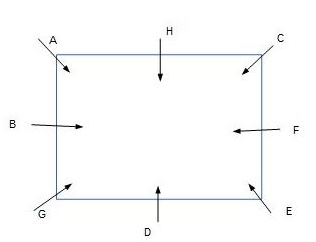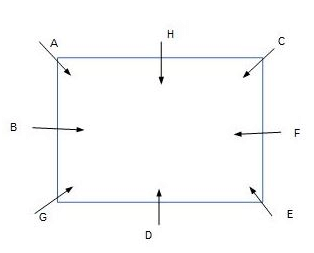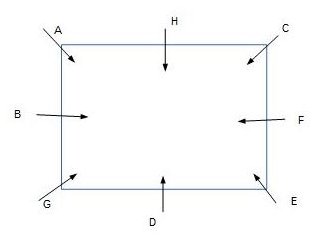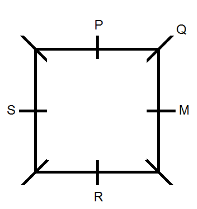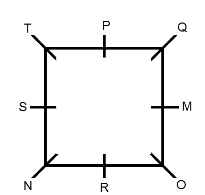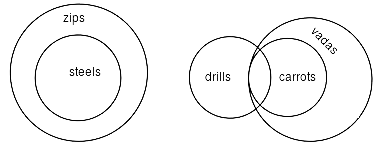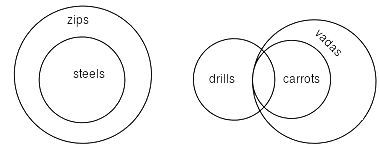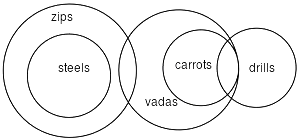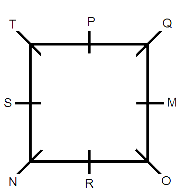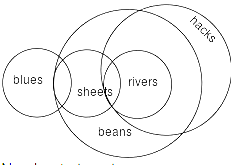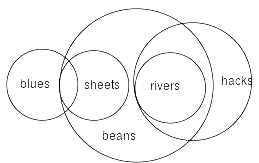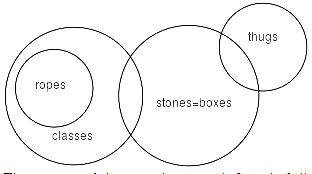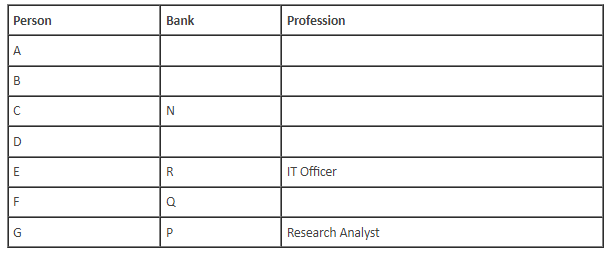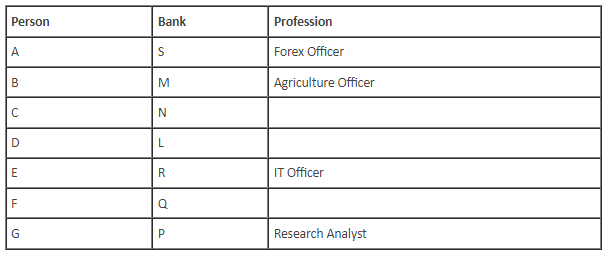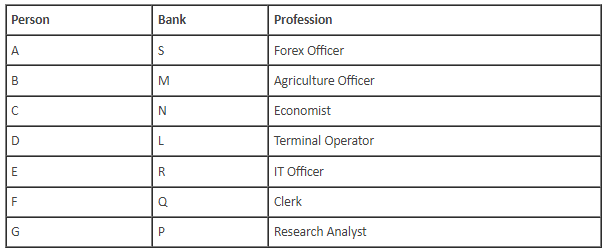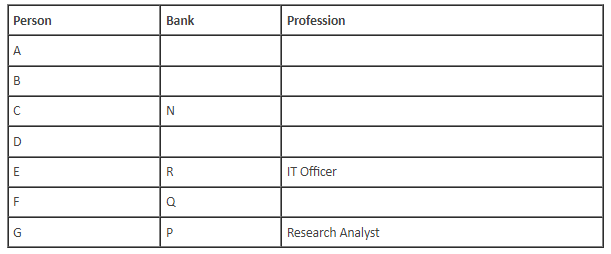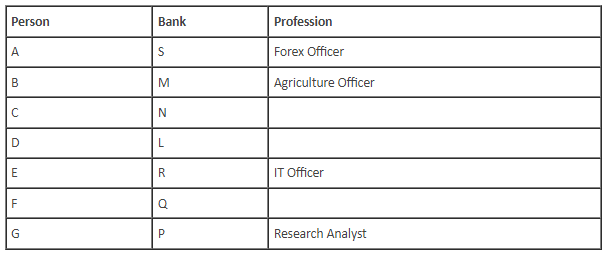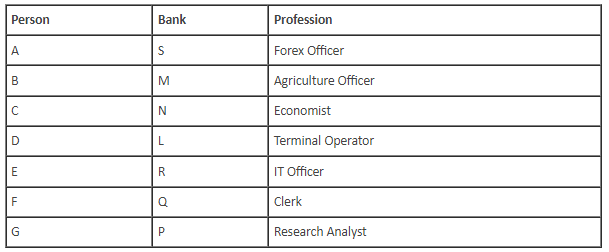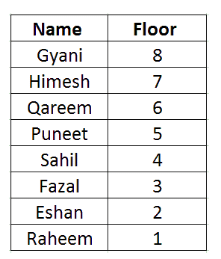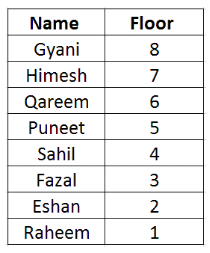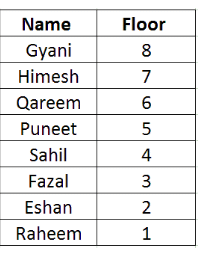IBPS SO Prelims Mock Test - 4 - Banking Exams MCQ
30 Questions MCQ Test - IBPS SO Prelims Mock Test - 4
In the following questions, the statements are followed by conclusions. Study the conclusions based on the given statements and select the appropriate option as your answer.
B = O > A > T; M = I ? N ? T
I. B = M
II. B > M
The ministry of aviation has ordered to procure 35 new aircraft to be added to the existing fleet this year. Which of the following most appropriately proves that the decision taken by the aviation minister is unrealistic and not based on scientific projections?
In the following questions, the statements are followed by conclusions. Study the conclusions based on the given statements and select the appropriate option as your answer.
T ? I ? P > Q = L = J ? K; L > D
I. D < K
II. T ? D
Directions: In making decisions about important questions, it is desirable to be able to distinguish between 'strong' arguments and 'weak' arguments. 'Strong' arguments are those which are both, important and directly related to the question. 'Weak' arguments are those which are of minor importance and also may not be directly related to the question or may be related to a trivial aspect of the question.
The question below is followed by three arguments numbered (A), (B) and (C). You have to decide which of the arguments is/are 'strong' argument(s) and which is/are 'weak' argument(s) and then choose your answer accordingly.
Should there be a complete ban on setting up thermal power plants in India?
Arguments:
(A) Yes, this is the only way to arrest further addition to environmental pollution.
(B) No, there is a huge shortage of electricity in most parts of the country and hence generation of electricity needs to be augmented.
(C) No, many developed countries continue to set up thermal power plants in their countries.
How many such pairs of letters are there in the word 'DAUGHTER' each of which has as many letters between them in the word as in the English alphabet?
Directions: Read the following information carefully and answer the question given below.
A, B, C, D, E, F, G and H are sitting around a square table facing the centre in such a way that four of them sit at four corners of the square, while the other four sit in the middle of each of the four sides.
(i) H sits second to right of F. F sits in the middle of one of the sides of the table.
(ii) G, who sits at any of the corners of the table, sits second to the left of E.
(iii) D sits facing H and only two people sit between D and A (taken from one side).
(iv) E is not an immediate neighbour of H and A is not an immediate neighbour of F.
(v) B sits second to the left of D.
Q. How many persons sit between D and C, when counted in anticlockwise direction from A?
Each of the questions below consists of a question and 2 statements numbered I and II. You have to decide whether the data provided in the statements are sufficient to answer the question.
6 persons A, B, C, D, E and F are standing in a line one behind another and all are facing north. Who is standing 2nd from the front end of the line?
I. A is standing behind D, who is standing 3rd from the front end of the line. Both C and F are standing ahead of B, who is standing ahead of E. Only 1 person is standing between B and A. B is standing ahead of A.
II. D and F are standing ahead of B, who is standing ahead of E and A. C is standing at the first position from the front end of the row. Only 3 persons is standing between F and A.
Read the following information carefully and answer the question given below.
A, B, C, D, E, F, G and H are sitting around a square table facing the centre in such a way that four of them sit at four corners of the square, while the other four sit in the middle of each of the four sides.
(i) H sits second to right of F. F sits in the middle of one of the sides of the table.
(ii) G, who sits at any of the corners of the table, sits second to the left of E.
(iii) D sits facing H and only two people sit between D and A (taken from one side).
(iv) E is not an immediate neighbour of H and A is not an immediate neighbour of F.
(v) B sits second to the left of D.
Q. What is the position of D with respect to B?
From the word 'ASTEROIDS', odd numbered letter from the right end are replaced with alphabetically 3rd next letter (e.g. B will be replaced with E) and even numbered letters from the right end are replaced with alphabetically 4th next letter (e.g. B will be replaced with F) then which of the following letter will appear more than once in the newly formed word?
Directions: Read the following information carefully and answer the question given below.
A, B, C, D, E, F, G and H are sitting around a square table facing the centre in such a way that four of them sit at four corners of the square, while the other four sit in the middle of each of the four sides.
(i) H sits second to right of F. F sits in the middle of one of the sides of the table.
(ii) G, who sits at any of the corners of the table, sits second to the left of E.
(iii) D sits facing H and only two people sit between D and A (taken from one side).
(iv) E is not an immediate neighbour of H and A is not an immediate neighbour of F.
(v) B sits second to the left of D.
Q. Who sits to the immediate left of the person sitting at the opposite corner of E?
Direction: Study the information given below and answer the question based on it.
H 9 T E ? K 1 J P 4 3 D @ F 2 © M A W 5 I * V 7 U 8 6 R $ Y Q
Q. Which of the following is exactly midway between J and 7 in the above arrangement?
Directions: Read the following information carefully and answer the question given below.
M, N, O, P, Q, R, S and T go for a party in a restaurant. They sit on a square table and face the centre in such a way that four of them sit in the middle of each of the four sides and rest sit at the corner of the table.
R sits second to the left of M. R sits in the middle of one of the sides of the table.
P sits second to the left of S, who does not sit at any of the corners of the table.
It is also known that only two people sit between P and N.
S is not an immediate neighbour of O.
N sits second to the right of T.
Q is not an immediate neighbour of S and is an immediate neighbour of P.
Q. How many people sit between M and T, when counted in clockwise direction from M?
In each of the questions below are given some statements followed by some conclusions. You have to take the given statements to be true even if they seem to be at variance from commonly known facts. Read all the conclusions and then decide which of the given conclusions logically follows from the given statements disregarding commonly known facts.
Statements:
All steels are zips
No zip is a drill.
Some drills are carrots.
All carrots are vadas.
Conclusion:
I. Some vadas are zips.
II. Some drills are steels.
III. No vada is a zip.
IV. Some carrots are zips
Directions: Read the following information carefully and answer the question given below.
M, N, O, P, Q, R, S and T go for a party in a restaurant. They sit on a square table and face the centre in such a way that four of them sit in the middle of each of the four sides and rest sit at the corner of the table.
R sits second to the left of M. R sits in the middle of one of the sides of the table.
P sits second to the left of S, who does not sit at any of the corners of the table.
It is also known that only two people sit between P and N.
S is not an immediate neighbour of O.
N sits second to the right of T.
Q is not an immediate neighbour of S and is an immediate neighbour of P.
What is the position of R with respect to O?
In each of the questions below are given some statements followed by some conclusions. You have to take the given statements to be true even if they seem to be at variance from commonly known facts. Read all the conclusions and then decide which of the given conclusions logically follows from the given statements disregarding commonly known facts.
Statements:
All rivers are hacks.
No hack is a blue.
Some blues are sheets.
All sheets are beans.
Conclusions:
I. All rivers being beans is a possibility.
II. Some sheets are rivers.
III. Some hacks are rivers.
IV. No sheet is a river.
In each of the questions below are given some statements followed by some conclusions. You have to take the given statements to be true even if they seem to be at variance from commonly known facts. Read all the conclusions and then decide which of the given conclusions logically follows from the given statements disregarding commonly known facts.
Statements:
All rivers are hacks.
No hack is a blue.
Some blues are sheets.
All sheets are beans.
Conclusions:
I. All rivers being beans is a possibility.
II. Some sheets are rivers.
III. Some hacks are rivers.
IV. No sheet is a river.
Directions: Study the following information to answer the given question.
A word and number arrangement machine when given an input line of words and numbers, rearranges them following a particular rule. Given below is an illustration of input and rearrangement.
Input: sum 28 have 19 96 48 luck nice 78 rope
Step I: have sum 28 19 48 luck nice 78 rope 96
Step II: luck have sum 28 19 48 nice rope 96 78
Step III: nice luck have sum 28 19 rope 96 78 48
Step IV: rope nice luck have sum 19 96 78 48 28
Step V: sum rope nice luck have 96 78 48 28 19
Step V is the last step of the rearrangement.
As per the rules followed in the above steps, answer the given question based on the input given below:
Input: 49 last zen 16 82 yet can vast 33 aim 87 54
Q. How many steps will be required to complete the arrangement?
In each of the questions below are given some statements followed by some conclusions. You have to take the given statements to be true even if they seem to be at variance from commonly known facts. Read all the conclusions and then decide which of the given conclusions logically follows from the given statements disregarding commonly known facts.
Statements:
All ropes are classes.
Some stones are classes.
All boxes are stones.
Some stones are thugs.
Conclusions:
I. Some ropes are boxes.
II. Some stones are not boxes.
III. No boxes are thugs.
IV. Some ropes are thugs.
Directions: Study the following information to answer the given question.
A word and number arrangement machine when given an input line of words and numbers, rearranges them following a particular rule. Given below is an illustration of input and rearrangement.
Input: sum 28 have 19 96 48 luck nice 78 rope
Step I: have sum 28 19 48 luck nice 78 rope 96
Step II: luck have sum 28 19 48 nice rope 96 78
Step III: nice luck have sum 28 19 rope 96 78 48
Step IV: rope nice luck have sum 19 96 78 48 28zen 49 last 16 82 yet can vast 33 aim 54 87
Step V: sum rope nice luck have 96 78 48 28 19
Step V is the last step of the rearrangement.
As per the rules followed in the above steps, answer the given question based on the input given below:
Input: 49 last zen 16 82 yet can vast 33 aim 87 54
Q. Which of the following would be Step I?
In the given sentences, a blank is given indicating that a word is missing. Among the four given options, a combination of words would fit the blank thereby making it grammatically and contextually correct. Choose that option as your response.
Being smart enough to adapt to our human-centric world is pretty incredible, but for raccoons it can be a liability; their _______ on our gardens and garbage get them a bad rep at best - at worst, it gets them killed by humans who see them as pests.
A. invasive
B. intrusion
C. withdrawal
D. encroachment
Directions: Study the following information to answer the given question.
A word and number arrangement machine when given an input line of words and numbers, rearranges them following a particular rule. Given below is an illustration of input and rearrangement.
Input: sum 28 have 19 96 48 luck nice 78 rope
Step I: have sum 28 19 48 luck nice 78 rope 96
Step II: luck have sum 28 19 48 nice rope 96 78
Step III: nice luck have sum 28 19 rope 96 78 48
Step IV: rope nice luck have sum 19 96 78 48 28
Step V: sum rope nice luck have 96 78 48 28 19
Step V is the last step of the rearrangement.
As per the rules followed in the above steps, answer the given question based on the input given below:
Input: 49 last zen 16 82 yet can vast 33 aim 87 54
Q. Which of the following would be the final arrangement?
In the given sentences, a blank is given indicating that a word is missing. Among the four given options, a combination of words would fit the blank thereby making it grammatically and contextually correct. Choose that option as your response.
Paradoxically, __________ reasoning does not always yield faulty results: even though your logic may be faulty, the answer you get may nevertheless be correct.
A. fallacious
B. erroneous
C. true
D. substantiated
Directions: Read the following passage carefully and answer the question given below it.
A group of seven friends A, B, C, D, E, F and G works as Economist, Agriculture Officer, IT Officer, Terminal Operator, Clerk, Forex Officer and Research Analyst for banks L, M, N, P, Q, R and S, but not necessarily in the same order. C works for Bank N and is neither a Research Analyst nor a Clerk. E is an IT Officer and works for Bank R. A works as a Forex Officer and does not work for Bank L or Q. The one who is an Agriculture Officer works for Bank M. The one who works for Bank L works as a Terminal Operator. F works for Bank Q. G works for Bank P as a Research Analyst. D is not an Agriculture Officer.
Q. Which of the following banks does D work for?
In the following passage, some of the words have been left out. Read the passage carefully and select the correct answer out of the five alternatives for the given blanks.
Prime Minister Narendra Modi tweeted a welcome to Justin Trudeau last evening five days after the Canadian Prime Minister and his family __(A)__ in India. The two leaders are expected to have a __(B)__ meeting today. Since Saturday, the Trudeaus toured the country amid talk of a snub by the political establishment over what's seen as Canada's soft stance on Sikhs who demand Khalistan. Yesterday, in a major diplomatic __(C)__, a Khalistani terrorist was found to have been invited by Canadian High Commissioner Nadir Patel for a dinner in Delhi. The visit of the 46-year-old Prime Minister who once __(D)__ that he had more Sikhs in his cabinet than PM Modi - is seen as an outreach to the Sikhs residing in Canada, who form a chunk of Mr. Trudeau's domestic constituency. An estimated 1.4 million people of Indian origin are __(E)__ in Canada.
Q. Which of the following words most appropriately fits the blank labeled (D)?
Directions: Read the following passage carefully and answer the question given below it.
A group of seven friends A, B, C, D, E, F and G works as Economist, Agriculture Officer, IT Officer, Terminal Operator, Clerk, Forex Officer and Research Analyst for banks L, M, N, P, Q, R and S, but not necessarily in the same order. C works for Bank N and is neither a Research Analyst nor a Clerk. E is an IT Officer and works for Bank R. A works as a Forex Officer and does not work for Bank L or Q. The one who is an Agriculture Officer works for Bank M. The one who works for Bank L works as a Terminal Operator. F works for Bank Q. G works for Bank P as a Research Analyst. D is not an Agriculture Officer.
Q. Who among the following works as a Clerk?
In the following passage, some of the words have been left out. Read the passage carefully and select the correct answer out of the five alternatives for the given blanks.
Prime Minister Narendra Modi tweeted a welcome to Justin Trudeau last evening five days after the Canadian Prime Minister and his family __(A)__ in India. The two leaders are expected to have a __(B)__ meeting today. Since Saturday, the Trudeaus toured the country amid talk of a snub by the political establishment over what's seen as Canada's soft stance on Sikhs who demand Khalistan. Yesterday, in a major diplomatic __(C)__, a Khalistani terrorist was found to have been invited by Canadian High Commissioner Nadir Patel for a dinner in Delhi. The visit of the 46-year-old Prime Minister who once __(D)__ that he had more Sikhs in his cabinet than PM Modi - is seen as an outreach to the Sikhs residing in Canada, who form a chunk of Mr. Trudeau's domestic constituency. An estimated 1.4 million people of Indian origin are __(E)__ in Canada.
Q. Which of the following words most appropriately fits the blank labeled (C)?
Directions: Read the following information and answer the question given below it.
Eight students, namely Puneet, Qareem, Raheem, Sahil, Eshan, Fazal, Gyani and Himesh, lives in a hostel which is an 8-storeyed building. Each floor is numbered from 1 to 8. The ground floor is floor number 1 and the topmost floor is floor number 8.
Sahil does not live on the topmost floor.
Eshan lives on the floor number which is exactly divisible by 2 and immediately below the floor where Fazal lives.
Raheem lives on the lowermost floor. Puneet lives immediately below the floor where Qareem lives.
Only one person lives between the floors of Himesh and Puneet.
Puneet lives below the floor where Himesh lives. Qareem lives on floor number 6.
Q. On which floor does Sahil live?
Read the sentence to find out whether there is an error in it. The error, if any, will be in one part of the sentence. If the given sentence is correct as it is, mark the answer as No error. Ignore the errors of punctuation if any.
Still struggling to evolve, this nascent industry (1)/ has been in news for a variety of reasons, (2)/ one, this intangible sector has sudden been witness to a (3)/ few high profile disproportionate investments. (4)
Directions: Read the following information and answer the question given below it.
Eight students, namely Puneet, Qareem, Raheem, Sahil, Eshan, Fazal, Gyani and Himesh, lives in a hostel which is an 8-storeyed building. Each floor is numbered from 1 to 8. The ground floor is floor number 1 and the topmost floor is floor number 8.
Sahil does not live on the topmost floor.
Eshan lives on the floor number which is exactly divisible by 2 and immediately below the floor where Fazal lives.
Raheem lives on the lowermost floor. Puneet lives immediately below the floor where Qareem lives.
Only one person lives between the floors of Himesh and Puneet.
Puneet lives below the floor where Himesh lives. Qareem lives on floor number 6.
Q. The number of people who live between the floors of Eshan and Qareem is
The great business remix of the last three years shows no sign of abating. Deep changes in technology and globalization that started in the 1990s continue to up-end how we live and work. They have forced firms to reshuffle the cards they hold and remix the ownership of assets in the economy. This was the third year in a row with more than 50,000 M&A (mergers and acquisition) deals announced worldwide according to Thomson Reuters - a record run. Prior to this, only 2007-2008 saw this many annual deals, and before that the single-year peak of 2000 saw just over 40,000 deals. In the last eleven years, we have seen over 500,000 M&A deals - more than in any such period in recent history.
What do the most remarkable deals of 2017 tell us about this remix and its effects on our daily lives? The $68 billion CVS-Aetna deal still puzzles shareholders and consumers - what will its effects be on our healthcare system? It is clearly part of the larger asset remix that started several years ago with deals in biopharma, such as Sanofi-Genzyme (2011), Novartis-GSK (2014), and a couple of failed attempts by Pfizer to merge and move its headquarters abroad. Then the insurance companies attempted to consolidate, and were blocked by the antitrust authorities. Hospitals, too, are merging horizontally when they can, as did pharmacy retailers. That left CVS and Aetna to break new ground with a vertical merger. The next few years will teach us about the effects of this new kind of asset remix.
The remix in media took a similar path. It too started with horizontal mergers being maxed out. AT&T was blocked from acquiring T-Mobile back in 2011 and Sprint and T-Mobile talked but couldn't get a deal done this year. But AT&T hasn't lost the urge to merge. Their $85 billion bid for Time Warner announced last year is another vertical merger, which the Justice Department decided this year to test in the courts. Disney's proposed acquisition of 21st Century Fox's entertainment assets is partly a classic horizontal consolidation, though it is more complex than that. An interesting angle to watch is what will happen to Hulu, the online competitor to Netflix that would become majority-controlled by Disney. That battle will be joined next year.
The remix in healthcare and in media has been partly driven by threats from the likes of Netflix and Amazon - the e-commerce disruption that dates to the early 2000s. The efficiencies of online business have continued to fell the old giants of retailing. But the battle of bricks vs. clicks has taken a new turn - partnerships and mergers between the two sides. Amazon's $13 billion acquisition of Whole Foods was the most visible deal in 2017 for most of us, but our pets may have noticed PetSmart's $3.4 billion acquisition of Chewy.com. And Walmart's 2016 acquisition of Jet.com seems to be yielding fruit - meaning we will be buying more and more online.
The tech world itself is also being remixed, and it started early in this merger cycle. The $67 billion merger of Dell and EMC and the $26 billion merger of Microsoft and LinkedIn both closed last year and are being implemented now. Apple, Facebook, and Google were quiet this year on the acquisition front (perhaps they have become big enough), beyond making fake merger news headlines. Still, there are pockets of tech that remain ripe for consolidation, according to Broadcom, which made a $105 billion hostile bid for Qualcomm, to the chagrin of Google and Microsoft, who fear Apple is behind this. Yes, the mighty tech gods are fighting for control of the machines that run our world.
Q. Which of the following could have been the motive(s) of the author behind penning down the 3rd para?
I. To provoke the thoughts behind the future effects of the mergers and acquisitions in the media industry.
II. The speed and the enormity with which the media companies are taking the M&A route.
III. The battle that is to follow between Netflix and Hulu in the coming times.
Directions: Read the following information and answer the question given below it.
Eight students, namely Puneet, Qareem, Raheem, Sahil, Eshan, Fazal, Gyani and Himesh, lives in a hostel which is an 8-storeyed building. Each floor is numbered from 1 to 8. The ground floor is floor number 1 and the topmost floor is floor number 8.
Sahil does not live on the topmost floor.
Eshan lives on the floor number which is exactly divisible by 2 and immediately below the floor where Fazal lives.
Raheem lives on the lowermost floor. Puneet lives immediately below the floor where Qareem lives.
Only one person lives between the floors of Himesh and Puneet.
Puneet lives below the floor where Himesh lives. Qareem lives on floor number 6.
Q. Who lives two floors above Raheem?




